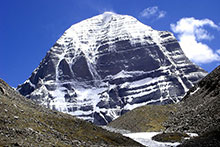“But the Tempter cannot master a man who dwells on the distasteful side of things, self-controlled in his senses, moderate in eating, resolute and full of faith, like the wind cannot move a mountain crag” (Dhammapada 8).
Buddha did not advocate a hating of life or self-loathing, but he did advocate a realistic view of the perishable world and all within it, including our body. He also urged his hearers to look beyond the attractive surface appearance of harmful things and see the poison and ugliness hidden therein.
It works the other way, too: we should look at what seems unattractive or miserable and see the benefits and healing they may bring. Buddha did not recommend either total acceptance or total rejection, but a clear-sighted understanding of all we encounter in earthly life. When we see the defects inherent in a thing we will not become addicted or unreasonably attached to it, nor will we loathe or avoid that which is essentially positive and helpful to us in our ascent to higher life. And at all times we should have a calm attitude to everything. This is the true Middle Way.
The other traits listed by Buddha as belonging to the Mara-resistant are just the opposite of the negative ones previously set forth, with one exception. He speaks of the wise man as being “full of faith.”
The seeker has not yet come to the goal, so how can he know he does not waste his time in pursuing it? If an enlightened person is at hand, he can see a living demonstration of the goal’s reality, but what if he cannot? By practice, which includes purification of heart, faith–which is not blind trust or hope but intuition that arises as the veils that cover the inner light are dissolved–arises and becomes established in him, giving him the perseverance needed to press on and attain the goal himself.
Such a person is likened by the Buddha to a mountain crag. Just as the crag cannot be moved because it is made of the very stone of the mountain and is organically united to the mountain, so the wise is anchored in spirit, is himself spirit irrevocably united to infinite Spirit. Knowing this, Emily Bronte wrote shorty before her death:
No coward soul is mine,
No trembler in the world’s storm-troubled sphere:
I see Heaven’s glories shine,
And Faith shines equal, arming me from Fear.O God within my breast,
Almighty, ever-present Deity!
Life, that in me has rest,
As I, undying Life, have power in Thee!Vain are the thousand creeds
That move men’s hearts: unutterably vain;
Worthless as withered weeds,
Or idlest froth amid the boundless main,To waken doubt in one
Holding so fast by Thy infinity,
So surely anchored on
The steadfast rock of Immortality.With wide-embracing love
Thy Spirit animates eternal years,
Pervades and broods above,
Changes, sustains, dissolves, creates, and rears.Though earth and moon were gone,
And suns and universes ceased to be,
And Thou wert left alone,
Every existence would exist in Thee.There is not room for Death,
Nor atom that his might could render void:
Thou–Thou art Being and Breath,
And what Thou art may never be destroyed.
This is the status of those who follow the Buddha Way. Already they begin to experience to a limited degree the limitless life of Buddhahood.
Further Reading:
- What is the Mind?: A Meditator’s Guide
- Learning to Use Your Mind
- Key Concepts in Yoga: Raga and Dwesha








